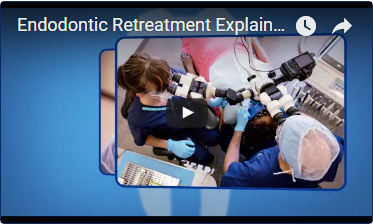With proper care, you’ll keep teeth that have had root canal treatment for a lifetime but it’s possible for those teeth to heal improperly, becoming painful or diseased months or even years after treatment. If this happens to your treated teeth you have a second chance to save the tooth with retreatment. An additional procedure may be able to diminish dental pain or discomfort and promote healing. If you suspect a tooth that had a prior root canal requires retreatment, visit your dentist or endodontist for evaluation.
As with any dental or medical procedure, it’s possible your tooth won’t heal as expected after initial treatment for a variety of reasons, including:
- Narrow or curved canals were not treated during the initial procedure.
- Complicated canal anatomy went undetected in the first procedure.
- The placement of the crown or other restoration was delayed following the endodontic treatment.
- The restoration did not prevent salivary contamination to the inside of the tooth.
A new problem can also jeopardize a tooth that was successfully treated, such as:
- New decay can expose the root canal filling material to bacteria, causing a new infection in the tooth.
- A loose, cracked or broken crown or filling can expose the tooth to new infection.
- A tooth sustains a fracture.
During retreatment, the endodontist will reopen your tooth and remove the filling materials that were placed in the root canals during the first procedure. The endodontist then carefully examines the tooth, looking for additional canals or new infection. The endodontist then removes any infection, cleans and shapes the canals, and places new filling materials. The opening is then sealed with a temporary filling. Once the tooth heals, a new crown or other restoration is placed on the tooth to protect it.
Read more about why you should consider endodontic retreatment to restore the health of your tooth.
Recommended Educational Video
Endodontic Retreatment Explained
It’s possible that a tooth that has undergone a root canal may heal improperly and require an additional treatment. Watch this video to learn more about this endodontic procedure.
Original Article Here.
Reprinted with permission of the AAE. Copyright © 2017 American Association of Endodontists. All Rights Reserved.
